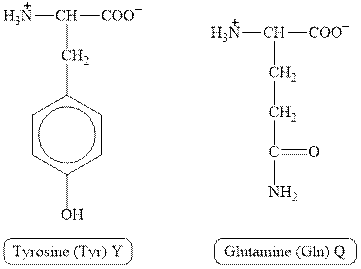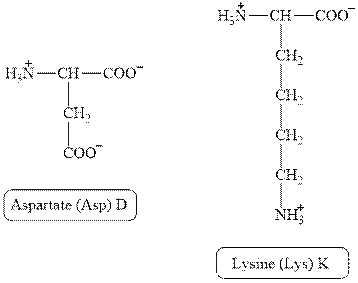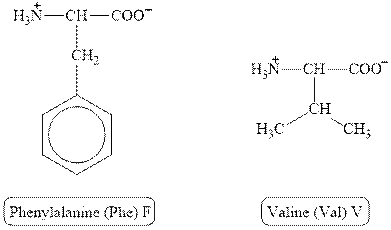
Concept explainers
(a)
Interpretation:
The type of interaction present between the side chains of tyrosine and glutamine is to be stated.
Concept introduction:
The structure of proteins has four stages. These four stages are: primary, secondary, tertiary and quaternary structures. In primary structure, the amino acids are arranged to give the backbone of protein. In secondary structure, the pattern of the peptide chain is arranged in certain order. In tertiary structure, the interactions between the side chains of amino acids are considered. In quaternary structure, two or more peptide chains are linked.
Answer to Problem 19.42E
The type of interaction present between the side chains of tyrosine and glutamine is hydrogen bonding.
Explanation of Solution
The structures of tyrosine and glutamine are shown in Figure 1.

Figure 1
In tyrosine, the side chain has
Therefore, the type of interaction present between the side chains of tyrosine and glutamine is hydrogen bonding.
The type of interaction present between the side chains of tyrosine and glutamine is hydrogen bonding.
(b)
Interpretation:
The type of interaction present between the side chains of aspartate and lysine is to be stated.
Concept introduction:
The structure of proteins has four stages. These four stages are: primary, secondary, tertiary and quaternary structures. In primary structure, the amino acids are arranged to give the backbone of protein. In secondary structure, the pattern of the peptide chain is arranged in certain order. In tertiary structure, the interactions between the side chains of amino acids are considered. In quaternary structure, two or more peptide chains are linked.
Answer to Problem 19.42E
The type of interaction present between the side chains of aspartate and lysine is salt bridge.
Explanation of Solution
The structures of aspartate and lysine are shown in Figure 2.

Figure 2
In aspartate, the side chain has
The type of interaction present between the side chains of aspartate and lysine is salt bridge.
(c)
Interpretation:
The type of interaction present between the side chains of leucine and isoleucine is to be stated.
Concept introduction:
The structure of proteins has four stages. These four stages are: primary, secondary, tertiary and quaternary structures. In primary structure, the amino acids are arranged to give the backbone of protein. In secondary structure, the pattern of the peptide chain is arranged in certain order. In tertiary structure, the interactions between the side chains of amino acids are considered. In quaternary structure, two or more peptide chains are linked.
Answer to Problem 19.42E
The type of interaction present between the side chains of leucine and isoleucine is hydrophobic interaction.
Explanation of Solution
The structures of leucine and isoleucine are shown in Figure 3.

Figure 3
In leucine, the side chain has
The type of interaction present between the side chains of leucine and isoleucine is hydrophobic interaction.
(d)
Interpretation:
The type of interaction present between the side chains of phenylalanine and valine is to be stated.
Concept introduction:
The structure of proteins has four stages. These four stages are: primary, secondary, tertiary and quaternary structures. In primary structure, the amino acids are arranged to give the backbone of protein. In secondary structure, the pattern of the peptide chain is arranged in certain order. In tertiary structure, the interactions between the side chains of amino acids are considered. In quaternary structure, two or more peptide chains are linked.
Answer to Problem 19.42E
The type of interaction present between the side chains of phenylalanine and valine is hydrophobic interaction.
Explanation of Solution
The structures of phenylalanine and valine are shown in Figure 4.

Figure 4
In phenylalanine, the side chain has
The type of interaction present between the side chains of phenylalanine and valine is hydrophobic interaction.
Want to see more full solutions like this?
Chapter 19 Solutions
Chemistry for Today: General, Organic, and Biochemistry
- Consider the tripeptide leucylvalyltryptophan. a. Specify its structure using three-letter symbols for the amino acids. b. How many peptide bonds are present within the peptide? c. Which of the amino acid residues has the largest R group? d. Which of the amino acid residues, if any, has a basic side chain?arrow_forwardWhat functional groups are found in all amino acids? How many different amino acids are found in naturally occurring proteins?arrow_forward
 General, Organic, and Biological ChemistryChemistryISBN:9781285853918Author:H. Stephen StokerPublisher:Cengage Learning
General, Organic, and Biological ChemistryChemistryISBN:9781285853918Author:H. Stephen StokerPublisher:Cengage Learning Organic And Biological ChemistryChemistryISBN:9781305081079Author:STOKER, H. Stephen (howard Stephen)Publisher:Cengage Learning,
Organic And Biological ChemistryChemistryISBN:9781305081079Author:STOKER, H. Stephen (howard Stephen)Publisher:Cengage Learning, World of Chemistry, 3rd editionChemistryISBN:9781133109655Author:Steven S. Zumdahl, Susan L. Zumdahl, Donald J. DeCostePublisher:Brooks / Cole / Cengage Learning
World of Chemistry, 3rd editionChemistryISBN:9781133109655Author:Steven S. Zumdahl, Susan L. Zumdahl, Donald J. DeCostePublisher:Brooks / Cole / Cengage Learning Living By Chemistry: First Edition TextbookChemistryISBN:9781559539418Author:Angelica StacyPublisher:MAC HIGHER
Living By Chemistry: First Edition TextbookChemistryISBN:9781559539418Author:Angelica StacyPublisher:MAC HIGHER Chemistry for Today: General, Organic, and Bioche...ChemistryISBN:9781305960060Author:Spencer L. Seager, Michael R. Slabaugh, Maren S. HansenPublisher:Cengage Learning
Chemistry for Today: General, Organic, and Bioche...ChemistryISBN:9781305960060Author:Spencer L. Seager, Michael R. Slabaugh, Maren S. HansenPublisher:Cengage Learning World of ChemistryChemistryISBN:9780618562763Author:Steven S. ZumdahlPublisher:Houghton Mifflin College Div
World of ChemistryChemistryISBN:9780618562763Author:Steven S. ZumdahlPublisher:Houghton Mifflin College Div





